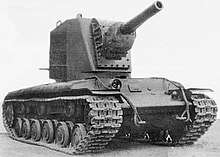Kliment Voroshilov tank
| KV-1 | |
|---|---|
|
KV-1 on display in Kirovsk. | |
| Type | Heavy tank |
| Place of origin | Soviet Union |
| Service history | |
| In service | 1939–1945 |
| Used by | Finland (Captured), Nazi Germany (Captured), Poland, Soviet Union |
| Wars | Winter War, World War II |
| Production history | |
| Designer | Zh. Kotin, TsKB-2 |
| Designed | 1938–1939 |
| Manufacturer | Kirov Factory, ChTZ |
| Produced | 1939–1943 |
| No. built | 5,219[1] |
| Variants | KV-2, KV-8 flamethrower, KV-1S, KV-85, KV-122 |
| Specifications (KV-1 Model 1941) | |
| Weight | 45 tonnes |
| Length | 6.75 m (22 ft 2 in) |
| Width | 3.32 m (10 ft 11 in) |
| Height | 2.71 m (8 ft 11 in) |
| Crew | 5 |
|
| |
| Armour |
|
Main armament | 76.2 mm M1941 ZiS-5 gun |
Secondary armament | 3× or 4× DT machine guns |
| Engine |
Model V-2 V12 Diesel engine 600 hp (450 kW) |
| Power/weight | 13 hp/tonne |
| Suspension | Torsion bar |
Operational range | 200–240 kilometres (120–150 mi) |
| Speed | 35 km/h (22 mph) |
| Kliment Voroshilov 2 | |
|---|---|
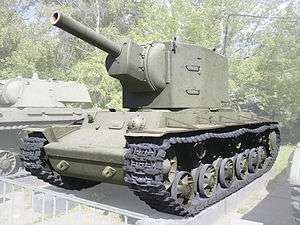 KV-2 in Moscow museum with KV-1 in background | |
| Type | Heavy tank/assault gun |
| Place of origin | Soviet Union |
| Service history | |
| In service | 1940-1945 |
| Used by | Soviet Union |
| Wars | World War II |
| Production history | |
| Designer | Zh. Kotin, TsKB-2 |
| Designed | 1938–1939 |
| Manufacturer | Kirov Factory, ChTZ |
| No. built | 334 |
| Specifications | |
| Weight | 52 tonnes |
| Length | 6.95 m (22 ft 10 in) |
| Width | 3.32 m (10 ft 11 in) |
| Height | 3.25 m (10 ft 8 in) |
| Crew | 6 |
|
| |
| Elevation | about 37° |
|
| |
| Armour | 60–110 mm (2.4–4.3 in) |
Main armament | 152 mm M-10T howitzer (20 rounds) |
Secondary armament | 2× DT machine guns (2,079 rounds) |
| Engine |
1 x V2-K-12 cylinder diesel 550 hp |
Operational range | 140 km (87 mi) |
| Speed | 28 km/h (17 mph) |
| KV-85 | |
|---|---|
|
KV-85 | |
| Type | Heavy tank |
| Place of origin | Soviet Union |
| Service history | |
| Used by | Soviet Union |
| Production history | |
| Produced | 1943 |
| No. built | 130 |
| Specifications | |
| Weight | 46 tonnes |
| Length | 8.49 m (27 ft 10 in) |
| Width | 3.25 m (10 ft 8 in) |
| Height | 2.87 m (9 ft 5 in) |
| Crew | 4 |
|
| |
| Armour | 30-160 mm |
Main armament | 85 mm D-5T tank gun |
Secondary armament | 3× 7.62 mm DT machine guns |
| Engine |
Mikulin Model V-2 V12 Diesel engine 600 hp |
| Power/weight | 11.8 hp/tonne |
| Suspension | Torsion bar |
Operational range | 250 km (155 mi) |
| Speed | 40 km/h (25 mph) |
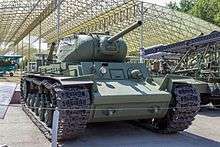
The Kliment Voroshilov (KV) tanks were a series of Soviet heavy tanks named after the Soviet defence commissar and politician Kliment Voroshilov and used by the Red Army during World War II. The KV series were known for their heavy armour protection during the early stages of the war, especially during the first year of the German invasion of the Soviet Union. In certain situations, even a single KV-1 or KV-2 supported by infantry was capable of halting large German formations. German tanks at that time were rarely used in KV encounters as their armament was too poor to deal with the "Russischer Koloss" – "Russian Colossus".[2]
The KV tanks were practically immune to the 3.7 cm KwK 36 and howitzer-like, short barreled 7.5 cm KwK 37 guns mounted, respectively, on the early Panzer III and Panzer IV tanks fielded by the invading German forces. Until more effective guns were developed by the Germans, the KV-1 was invulnerable to almost any German weapon except the 8.8 cm Flak gun.[3]
Prior to Operation Barbarossa, about 500 of the over 22,000 tanks then in Soviet service were of the KV-1 type. As the war progressed, it became evident that there was little sense in producing the expensive KV tanks, as the T-34 medium tank performed better (or at least equally well) in all practical respects. In fact the only advantage it had over the T-34/76 was its larger and roomier three-man turret.[4] Later in the war, the KV series became a base for the development of the IS (Iosif Stalin) series of tanks and self-propelled guns.
Development history
After disappointing results with the multi-turreted T-35 heavy tank, Soviet tank designers started drawing up replacements. The T-35 conformed to the 1920s notion of a "breakthrough tank" with very heavy firepower and armour protection, but suffered from poor mobility. The Spanish Civil War demonstrated the need for much heavier armour on tanks, and was the main influence on Soviet tank design just prior to World War II.
Several competing designs were offered, and even more were drawn up prior to reaching prototype stage. All had heavy armour, torsion-bar suspension, wide tracks, and were of welded and cast construction. One of the main competing designs was the SMK, which in its final form had two turrets, mounting one 76.2 mm and one 45 mm weapon. The designers of the SMK independently drew up a single-turreted variant and this received approval at the highest level. Two of these, named after the People's Defence Commissioner, were ordered alongside a single SMK. The smaller hull and single turret enabled the designer to install heavy frontal and turret armour while keeping the weight within manageable limits.
The KV was ordered right off the drawing board.[5] When the Soviets entered the Winter War, the SMK, KV and a third design, the T-100, were sent to be tested in combat conditions. The KV outperformed the SMK and T-100 designs. The KV's heavy armour proved highly resistant to Finnish anti-tank weapons, making it more difficult to stop. In 1939, the production of 50 KVs was ordered. During the war, the Soviets found it difficult to deal with the concrete bunkers used by the Finns and a request was made for a tank with a large howitzer. One of the rush projects to meet the request put the howitzer in a new turret on one of the KV tanks.[6] Initially known as 'Little turret KV' and 'Big turret KV', the 76-mm-armed tank was redesignated as the KV-1 Heavy Tank and the 152 mm howitzer one as KV-2 Heavy Artillery Tank.
KV tanks first faced the Germans in the Battle of Raseiniai, just after the start of Operation Barbarossa. On 23 June, over 200 German tanks advancing through Lithuania encountered Soviet armor, including KV-1 and KV-2 tanks. While their frontal armor was sufficient to deflect anti-tank fire, German troops were able to outflank them and destroy them with explosive charges or lure them to within point-blank range of direct-fire artillery. Of the more than 200 Soviet tanks lost at Raseiniai, 29 were KVs.[5]
The KV's strengths included armour that was impenetrable by any tank-mounted weapon then in service[7] except at point-blank range, that it had good firepower, and that it had good flotation on soft ground. It also had serious flaws: it was difficult to steer; the transmission (which was a twenty-year-old Holt Caterpillar design)[8] "was the main stumbling block of the KV-1, and there was some truth to rumors of Soviet drivers having to shift gears with a hand sledge";[8] and the ergonomics were poor, with limited visibility.[9] Furthermore, at 45 tons, it was simply too heavy. This severely impacted the maneuverability, not so much in terms of maximum speed, as through inability to cross many bridges medium tanks could cross.[10] The KV outweighed most other tanks of the era, being about twice as heavy as the heaviest German tank at that time (before the Tiger). As appliqué armour and other improvements were added without increasing engine power, later models were less capable of keeping up to speed with medium tanks and had more trouble with difficult terrain. In addition, its firepower was no better than that of the T-34.[8] It took field reports from senior commanders "and certified heroes", who could be honest without risk of punishment, to reveal "what a dog the KV-1 really was".[8]
Further development
By 1942, when the Germans were fielding large numbers of long-barrelled 50 mm and 75 mm guns, the KV's armour was no longer impenetrable, requiring the installation of additional appliqué armour. The KV-1's side (favorable approach: 30° degree at 300–500 m distance), top, and turret armour could also be penetrated by the high-velocity Mk 101 30 mm cannon carried by German ground attack aircraft, such as the Henschel Hs 129.[11] The KV-1's 76.2 mm gun also came in for criticism. While adequate against all German tanks, it was the same gun as carried by smaller, faster, and cheaper T-34 medium tanks. In 1943, it was determined that this gun could not easily penetrate the frontal armour of the new Tiger,[12] the first German heavy tank, one of which was captured near Leningrad. The KV-1 was also much more difficult to manufacture and thus more expensive than the T-34. In short, its advantages no longer outweighed its drawbacks.
Nonetheless, because of its initial superior performance, the KV-1 was chosen as one of the few tanks to continue being built following the Soviet reorganization of tank production. Due to the new standardization, it shared a similar engine and gun as the T-34 (the KV used a 600 hp V-2K modification of the T-34's V-2 diesel engine, and had a ZiS-5 main gun while the T-34 had a similar F-34 main gun), was built in large quantities, and received frequent upgrades.
When production shifted to the Ural Mountains "Tankograd" complex, the KV-2 was dropped. While impressive on paper, it had been designed as a slow-moving bunker-buster. It was less useful in the highly mobile, fluid warfare that developed in World War II. The turret was so heavy it was difficult to traverse on uneven terrain. Finally, it was expensive to produce. Only about 300 KV-2s were made, all in 1940-41, making it one of the rarest Soviet tanks.
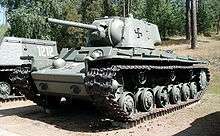
As the war continued, the KV-1 continued to get more armour to compensate for the increasing effectiveness of German weapons. This culminated in the KV-1 model 1942 (German designation KV-1C), which had very heavy armour, but lacked a corresponding improvement to the engine. Tankers complained that, although they were well-protected, their mobility was poor and they had no firepower advantage over the T-34 medium tank.
KV-1S
In response to criticisms, the lighter KV-1S was developed, with thinner armour and a smaller, lower turret in order to reclaim some speed. Importantly, the KV-1S had a commander's cupola with all-around vision blocks. It also had a sophisticated planetary transmission that significantly increased the reliability, and allowed use of more efficient regenerative geared steering, unlike the solely clutch and brake steering systems used by the Panzer III, IV and T-34 (and previous KV tanks). Its reduced weight allowed it to achieve a top speed of 43.3 km/h. Over 1,300 were built before production ended in August 1943.[13] Although the KV-1S was, according to some, the best of the KV tanks, overcoming its predecessors' problems (at a cost of losing the heavy armor that made the earlier tanks so valuable, making it more of slow medium tank than a heavy tank), more modern tanks were already in sight.[14] Up-arming the regular turret of the KV-1S with an 85 mm S-31 resulted in the KV-1S-85. This was rejected as it came with the unacceptable loss of a dedicated commander, reducing the turret crew to two (unlike the 3-man turret fitted to the T-34/85).[15] However, the thinning-out of the armour called into question why the tank was being produced at all, when the T-34 could seemingly do everything the KV could do and much more cheaply. The Soviet heavy tank program was close to cancellation in mid-1943.
The appearance of the German Panther tank in the summer of 1943 convinced the Red Army to make a serious upgrade of its tank force for the first time since 1941. Soviet tanks needed bigger guns to take on the growing numbers of Panthers and the few Tigers.
KV-85
A stopgap upgrade to the KV series was the short-lived KV-85 or Objekt 239. This was a KV-1S with the new turret from the Object 237 (IS-85) still in development, mounting the same 85 mm D-5T gun as the SU-85 and early versions of the T-34-85 (not yet in production at the time). The 85 mm proved capable of penetrating the Tiger I from 1000 m and the demand for it slowed production of the KV-85 tremendously (only 148 were built in the end). The KV-85 appeared on the front beginning in September 1943 and its production ended by December 1943.[16] Soviet industry was therefore able to produce a heavy tank as well armed as the Tiger I before the end of 1943. Although the KV-85 was an excellent opponent to the Tigers and Panthers, it was a stopgap and thus was built in small numbers.[13] The complete Object 237 was accepted into service as the IS-85 and was produced in the autumn and winter of 1943-44; they were sent to the front as of October 1943 and production of the IS-85/IS-1 was stopped by the spring of 1944 once the IS-122/IS-2 entered full-scale production.
Successor
A new heavy tank design entered production late in 1943 based on the work done on the KV-13. Because Voroshilov had fallen out of political favour, the new heavy tank series was named the Iosif Stalin tank, after the Soviet leader Stalin. The KV-13 program's IS-85 prototype was accepted for production as the IS-1 (or IS-85, Object 237) heavy tank. After testing with both the 100 mm D-10 and 122 mm guns, the D-25T 122 mm gun was selected as the main armament of the new tank, primarily because of its ready availability and the effect of its large high-explosive shell when attacking German fortifications. The 122 mm D-25T used a separate shell and powder charge, resulting in a lower rate of fire and reduced ammunition capacity. While the 122 mm armour-piercing shell had a lower muzzle velocity than similar late German 7.5 cm and 8.8 cm guns, proving-ground tests established that the 122 mm could penetrate the frontal armour of the German Panther tank at 2500 metres[17] and the HE shell would easily blow off the drive sprocket and tread of the heaviest German tank or self-propelled gun. The IS-122 replaced the IS-85, and began mass production as the IS-2. The 85 mm gun saw service in the lighter SU-85 and T-34-85.
Models
The Soviets did not recognize different production models of KV-1 during the war; designations like model 1939 (M1939, Russian: Obr. 1939) were introduced later in military publications. These designations, however, are not strict and describe leading changes, while other changes might be adapted earlier or later in specific production batches. Designations like KV-1A were applied by the Germans during the war. All tanks in the series were heavily based on the KV-1.

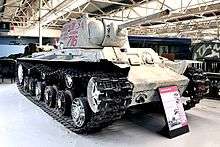
- KV-1
- Model 1939 – First production models, these tanks were prone to frequent breakdowns, but were highly resistant to anti-tank weapons during the Winter War. Armed with the 76 mm L-11 tank gun, recognizable due to a recuperator above a barrel. Most tanks were lacking the hull machine gun. 141 were built.
- Model 1940 (German designation: KV-1A) – Used the F-32 76 mm gun and a new mantlet. The main production model by the time of the German invasion.
- Model 1940 s ekranami ("with screens") or KV-1E – with additional bolted-on appliqué armour and F-32 gun.
- Model 1941 (German designation: KV-1B) – Up-armoured with 25–35 mm (0.98–1.38 in) added to the turret, hull front and sides. Turret was now cast instead of welded. This tank was armed with the longer-barreled ZiS-5, tank gun.
- Model 1942 (German designation: KV-1C) – Fully cast turret with thicker armour or welded turret with thicker armour, again up-armoured, using an improved engine and the 76 mm ZiS-5 tank gun.
- KV-1S – A variant with higher speed, but thinner armour. A new, smaller, cast turret and redesigned rear hull with a new planetary transmission. 1370 built.
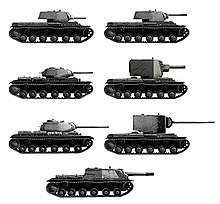
- KV-2 (334) – A heavy assault tank with the M-10 152 mm howitzer, the KV-2 was produced at the same time as the KV-1. Due to the size of its heavy turret and gun, the KV-2 was slower and had a much higher profile than the KV-1. Those captured and used by the German Army were known as (Sturm)Panzerkampfwagen KV-II 754(r). Few were produced due to its combat ineffectiveness, mainly the decreased speed due to the weight of the new gun and turret. Due to an increase in turret weight from the expanded dimensions and a heavier gun, the turret traverse mechanism could work only on level ground.
- Т-150 (Object 150) - Experimental. Armour - 90 mm, Weight - 51 tons. New 700 hp engine. Turret had a cupola but was in all other ways identical to the turret of the KV-1. One prototype was constructed in 1941 and was destroyed defending Leningrad.
- KV-3 (Objects 221, 222, and 223) - Experimental. Longer chassis (7 rollers per side). The first design (Object 221) was never built, but it was supposed to have an 85 mm gun. The same thing happened to Object 222, but it was supposed to have a F-32 76.2 mm gun. The Objects 221 and 222 both used a new modified KV-1 turret. Object 223's hull was built and was tested with weights to simulate the new conical turret (housing a 107 mm ZiS-6 cannon) that was designed for it. Object 223 had up to 120 mm of sloped armour. Series production was intended to start in late 1941, but the German invasion of the USSR halted these plans and the only prototype hull was destroyed.
- KV-4 (Object 224) - A project for a super-heavy tank. About 20 different designs were proposed, but it was cancelled due to the outbreak of the war. Different versions would have been between about 85 and 110 tonnes. Armour from about 120 to 190 mm. Armament consisted of the 107 mm ZiS-6 cannon. Different variants had various auxiliary weapons: 45 mm, 76 mm cannons, machineguns and flamethrowers in addition to the main gun.[19]
- KV-5 (Object 225) - A cancelled project for a super-heavy tank. Armament was to be a 107 mm ZiS-6 gun in a large turret and machine-gun in a small secondary turret. Weight was projected as about 100 tons, and the tank was to have 150–180 mm of armour. Project development began in June 1941, however was cancelled due to the Siege of Leningrad, in which all developmental operations at the Kirov Plant were halted. The project fell out of favour from the more advanced heavy tank designs, and no prototype was built.[19]
- KV-7 (Object 227) (also called U-13). - Experimental self-propelled gun. armed with 3 cannons: two 45 mm model 1932/34 and one 76 mm F-34. 200 rounds of ammunition was carried for the 45 mm guns and 93 rounds for the 76 mm gun, and the tank had 100 mm of frontal armour. One unit was produced and tested in 1941.
- KV-7-2 (improved variant) (also called U-14) had two 76 mm F-34 cannons, and 85 mm of frontal armour. Vehicles were not taken in service primarily because they could not fight tanks (the KV-7s had only 15 degree gun traverse to each side) and could not combat concrete bunkers due to the small caliber of the guns. After the failure of the KV-7 it was decided to put one 152 mm gun in the casemate instead of three smaller guns; this led to the development of the SU-152.
- U-18 - Experimental self-propelled gun. KV-7 armed with 152 mm ML-20 cannon. Vehicle was projected in 1941. Wooden mockup was constructed. Project was cancelled, but this vehicle was a first step towards SU-152 design.
- S-51 (also called U-19) - Experimental self-propelled gun projected by the Grabin Artillery Projects Central Department armed with the 203 mm howitzer M1931 (B-4) cannon in a KV-1S hull. The vehicle was to have 75 mm of frontal armour, 60 mm on the side, and the roof was to be 30 mm (the roof would have been removable to facilitate loading). It was projected to weigh 66 tons, one prototype passed by the testing grounds in the spring of 1944 but it was not very successful and was cancelled within a year.
- SU-152 - See SU-152. Heavy assault gun based on the KV-1S chassis.
- ZiK-20 - The ZiK-20 was very similar to the U-19 (S-51), but had 105 mm of frontal armour, and 75 mm of side armour and was to mount a ML-20 gun. By the time was wooden mockup was made the KV-1 was phased out of production. However just before the project was cancelled a blueprint was drawn up to equip the ZiK-20 with a Br-2 152.4 mm gun; and to offset the weight the frontal armour was to be reduced to 75 mm (or 60 mm on the KV-1S chassis).
- SU-203 - SU-152 equipped with 203 mm M-4 mortar. Never built.
- KV-8 (42) – A KV-1 fitted with the ATO-41 flamethrower in the turret, beside a machine gun. In order to accommodate the new weapon, the 76.2 mm gun was replaced with a smaller 45 mm Gun M1932, though it was disguised to look like the standard 76 mm (the cannon was placed inside a 76 mm tube).
- KV-8S (25) – The same as KV-8, but based on KV-1S. Equipped with ATO-42 flamethrower (improved version of ATO-41).
- KV-8M - Upgraded version of KV-8S. Equipped with two flamethrowers. Two prototypes were constructed.
- KV-9 (Object 229) - A KV-1 with short 122 mm U-11 cannon. One prototype was constructed and proved in 1941.
- KV-10 (Object 230) - Also known as KV-1K. A KV-1 with 4 rocket launchers on the sides of hull. Each launcher contained two 132 mm M-13 rockets. Early variant of KV-1K had two launchers on the back of hull, each contained 6 rockets. One prototype was constructed and tested in 1942. Not taken in service.
- KV-11 (Object 231) - KV-1 armed with 85 mm F-30 cannon. Projected in 1942. Not built.
- KV-12 (Object 232) - Experimental chemical tank. Was equipped with 4 external toxin tanks on the back of chassis. Tanks surrounded with 30 mm armour. Not taken in service.
- KV-13 (Object 233) - Prototype of a medium tank. Designation for an advanced redesign of the KV series, which resulted in the production of the IS series.
- IS Model 2 - A KV-13, with turret and armament from KV-9. One prototype was constructed and proved in 1943. Tank had lost competition to IS Model 1 and was not taken in service.
- KV-14 (Object 236) – Prototype designation for a 152 mm self-propelled gun, accepted for service as the SU-152.
- KV-85 (Object 239) – A KV-1S with the 85 mm D-5T cannon in a new turret, with the ball mounted hull machine gun removed and the hole welded shut, 148 of these tanks were produced in the second half of 1943 until the spring of 1944; they were a stopgap until the IS tank series entered production.[20]
- KV-85G - KV-1S with 85 mm S-31 cannon. Turret and mantlet remained from conventional KV-1S. This variant was a competitor of KV-85 during proving. It lost the competition and was not taken in service.
- KV-122 - A KV-1S with short 122 mm S-41 howitzer. One prototype was made in 1943. Not taken in service.[21]
- KV-100 - A KV-85 with the 100 mm S-34 cannon. One prototype was made in 1944. Not taken in service.
- KV-122 - A KV-85 with the 122 mm D-25T cannon. One prototype was made in 1944. Not taken in service.
- KV-152 - Proposal to fit a 152 mm gun into the turret of a KV-85. Nothing became of the project.
- KV-220 (Object 220) - Experimental. Longer chassis (7 rollers per side). Armour - 100 mm. New 850 hp V-2SN engine with turbocharging. New diamond-shaped turret. 85 mm F-30 cannon. One prototype was constructed in 1941. The tank was lost in battle after a direct hit to the frontal hull by a 150 mm howitzer sFH 18 in December 1941.[22][23]
KV and other heavy Soviet tanks compared
| T-35 | T-100 | SMK | KV-1 M1940 |
KV-1 M1941 |
KV-1 M1942 |
KV-1S M1942 |
KV-85 M1943 |
IS-2 M1945 |
IS-3[25] M1945 | |
|---|---|---|---|---|---|---|---|---|---|---|
| Crew | 11 | 7 | 7 | 5 | 5 | 5 | 5 | 4 | 4 | 4 |
| Weight (tonnes) | 45 | 58 | 55 | 43 | 45 | 47 | 42.5 | 46 | 46 | 46.5 |
| Gun | 76.2 mm M. 27/32 |
76.2 mm L-11 (L/30.5) |
76.2 mm L-11 |
76.2 mm F-32 (L/31.5) |
76.2 mm ZiS-5 (L/42.5) |
76.2 mm ZiS-5 |
76.2 mm ZiS-5 |
85 mm D-5T |
122 mm D-25T |
122 mm D-25T |
| Ammunition | 100 | – | – | 111 | 111 | 114 | 114 | 70 | 28 | 28 |
| Secondary armament | 2×45 mm 5×7.62 mm |
45 mm | 45 mm | 2×DT | 4×DT | 4×DT | 4×DT | 3×DT | 3×DT, DShK | 2×DT, DShK |
| Engine | 500 hp M-17M gasoline |
500 hp | 850 hp AM-34 |
600 hp V-2K diesel |
600 hp V-2 |
600 hp V-2 |
600 hp V-2 |
600 hp V-2 |
600 hp V-2 |
600 hp V-2-IS |
| Fuel (litres) | 910 | – | – | 600 | 600 | 600 | 975 | 975 | 820 | 520 + 270 |
| Road speed (km/h) | 30 | 35 | 36 | 35 | 35 | 28 | 45 | 40 | 37 | 37 |
| Road range (km) | 150 | – | 150 | 200-240 | 200-240 | 250 | 250 | 250 | 240 | 150 (225) |
| Armour (mm) | 11–30 | 20–70 | 20–60 | 25–75 | 30–90 | 20–130 | 30–82 | 30–160 | 30–160 | 20–220 |
Combat history
Raseiniai

A KV-1 or KV-2 tank (accounts vary) advanced far behind the German lines after attacking a column of German trucks. The tank stopped on a road across soft ground and was engaged by four 50 mm anti-tank guns of the 6th Panzer Division's anti-tank battalion. The tank was hit multiple times by these guns but fired back, disabling all four guns. A heavy 88 mm gun of the division's anti-aircraft battalion was moved about 730 metres (800 yd) behind the tank but was knocked out by the tank before it could score a hit. During the night, German combat engineers attempted to destroy the tank with satchel charges, but were unable to, despite possibly damaging the tracks. Early on the morning of 25 June, German tanks fired on the KV from the woodland while an 88 mm targeted the tank from its rear. Of several shots fired, only two penetrated the tank. German infantry then advanced, with the KV opening machine-gun fire against them.[26] The tank's resistance was finally ended by grenades thrown into the tank's hatches. According to some accounts, the crew was buried by the German soldiers with full military honors; in other accounts, the crew escaped during the night.[26]
General Erhard Raus was Commander of the 6th Panzer Division's Kampfgruppe,[f] the unit delayed by the lone vehicle. He described it as a KV-1, which was damaged by several 88mm anti-tank gun shots fired from behind the vehicle while it was distracted by Panzer 35(t) tanks from Panzer Battalion 65, and the KV-1 crew were killed by members of a pioneer unit who pushed grenades through two holes made by the gun while the turret began moving again, the other five or six shots having not fully penetrated. Apparently, the KV-1 crew had remarkably only been stunned by the shots which had entered the turret. Afterwards, they were buried nearby with military honors by the German unit.[27][lower-alpha 1]
Some KVs remained in service right up to the end of the war, although in greatly diminishing numbers as they wore out or were knocked out. The 260th Guards Heavy Breakthrough Tank Regiment, based on the Leningrad front, operated a number of 1941-vintage KV-1s at least as late as the summer of 1944 before re-equipping with IS-2s. A regiment of KVs saw service in Manchuria in August 1945, and a few KV-85s were used in Crimea in the summer of 1944. The Finnish forces had two KV-1s, nicknamed Klimi, a Model 1940 and Model 1941, both of which received minor upgrades in their service, and both of which survived the war.
Romanian forces captured one KV-1 as of 1 November 1942 and one more in March 1944.[29]
Production
| Year | KV-1 | KV-2 and KV2A | KV-1S | KV-85 | SU-152 |
|---|---|---|---|---|---|
| 1940 | 141 | 102 | |||
| 1941 | 1,121 | 232 | |||
| 1942 | 1,753 | 780 | |||
| 1943 | 452 | 130 | 704 | ||
| 1944 | |||||
| 1945 | |||||
| Total | 3,015 | 334 | 1,231 | 130 | 704 |
See also
Tanks of comparable role, performance and era
- German Tiger I
- United States M6 heavy tank
- British Churchill tank
References
Footnotes
- ↑ In 1965, the remains of the crew were exhumed and reburied at the military cemetery in Raseiniai. According to research by Russian military historian Maxim Kolomiets, the tank may have been from the 3rd Company of the 1st Battalion, 4th Tank Regiment, part of the 2nd Tank Division. It is impossible to clarify the crew's names because the relevant documents were buried in the woods north of Raseiniai during the retreat.[28]
Citations
- ↑ Zaloga; including variants and prototypes
- ↑ Vollert, Jochen (2005). Tankograd Militar Fahrzeug - Special No. 2003 Soviet Special - KV-1 Soviet Heavy Tanks of WWII - Late Variants. Tankograd Publishing. p. 59.
- ↑ Glantz, David M. (1995). When Titans Clash: How the Red Army Stopped Hitler. University Press of Kansas. p. 36. ISBN 9780700608997.
- ↑ Ogorkiewicz, Richard (2015). Tanks: 100 years of evolution. Osprey. p. 94.
- 1 2 The KV-1 Tank Blundered Its Way Into History - Warisboring.com, 17 October 2016
- ↑ Zaloga p. 7
- ↑ Russel H. S. Stolfi. Hitler's panzers east: World War II reinterpreted. p. 158.
- 1 2 3 4 Sewell, Stephen, CW2 (rtd), "Why Three Tanks?", Armor (July–August 1998), p. 24 – via tankandafvnews.com
- ↑ Zaloga. KV-1 & 2: Heavy Tanks 1939–1945. p. 9.
- ↑ Steven J. Zaloga; Peter Sarson. IS-2 Heavy Tank 1944–73. p. 3.
- ↑ Pegg, Martin (1997). Hs 129 Panzerjager!. Classic Publications. ISBN 0952686716.
- ↑ Dmitry Pyatakhin. "The New Generation of Soviet Armor vs. Tigers". Retrieved 3 January 2011.
- 1 2 Vollert, Jochen (2005). Tankograd Militar Fahrzeug - Special No. 2003 Soviet Special - KV-1 Soviet Heavy Tanks of WWII - Late Variants. Tankograd Publishing. p. 33.
- ↑ Vollert (2005), p. 34.
- ↑ Vollert (2005), p. 40.
- ↑ Boldyrev, Eugeni. "KV-85 Heavy Tank". The Russian Battlefield. Retrieved 20 October 2014.
- ↑ Tolochkov; Volosatov (September 12, 1944). "Report on the Results of Testing of the 100 mm and the 122 mm Tank Guns at the Kubinka Proving Grounds". The Russian Battlefield. Retrieved 27 October 2014.
- ↑ Zaloga 1984, pp.118–19
- 1 2 Zaloga (2013), p. 16.
- ↑ Boldyrev, Eugeni. "KV-85 Heavy Tank". english.battlefield.ru. Retrieved 20 October 2014.
- ↑ Солянкин А.Г., Павлов М.В., Павлов И.В., Желтов И.Т. Отечественные бронированные машины. ХХ век. Том 2. 1941–1945 (Domestic Armoured Vehicles. XXth Century. Volume 2. 1941–1945). Moscow, 2005. P. 238
- ↑ Potapov, Valeri. "KV-3, KV-4, KV-5, KV-7, KV-9, KV-220". The Russian Battlefield. Retrieved 25 October 2014.
- ↑ Zaloga, Steven (1996). KV-1 & 2 Heavy Tanks 1939-45. Osprey Publishing. p. 13. ISBN 1855324962.
- ↑ Zaloga & Grandsen (1984) pp. 119, 176
- ↑ IS-3 Model 1945 onwar.com
- 1 2 Buttar 2013, p. 85.
- ↑ Raus 2003, pp. 32–33.
- ↑ Dobrovolsky, Alexander (29 April 2015). "Один день из жизни "Климента Ворошилова"" [A Day in the Life of a Kliment Voroshilov]. Moskovsky Komsomolets (in Russian). Retrieved 11 October 2016.
- ↑ Mark Axworthy, Cornel I. Scafeș, Cristian Crăciunoiu, Third Axis, Fourth Ally: Romanian Armed Forces in the European War, 1941-1945, pp. 220 and 221
- ↑ Russian tanks and armoured vehicles 1917-1945, by W Fleischer, p170,
Bibliography
- Raus, Erhard (2003). Panzer operations: the Eastern Front memoir of General Raus, 1941-1945. Translated by Steven H. Newton. Da Capo Press. ISBN 978-0-306-81247-7.
- Vollert, Jochen (2005). Tankograd Militar Fahrzeug - Special No. 2003 Soviet Special - KV-1 Soviet Heavy Tanks of WWII - Late Variants. Tankograd Publishing.
- Zaloga, Steven J; James Grandsen (1981). Soviet Heavy Tanks. London: Osprey Publishing. ISBN 0-85045-422-0.
- Zaloga, Steven J. and James Grandsen (1984). Soviet Tanks and Combat Vehicles of World War Two. London: Arms and Armour Press. ISBN 0-85368-606-8
- Zaloga, Steven J., Jim Kinnear, and Peter Sarson (1995). KV-1 & 2 Heavy Tanks 1939–1945. Oxford: Osprey Publishing. ISBN 1-85532-496-2
External links
| Wikimedia Commons has media related to KV tanks. |
- OnWar specifications: KV-1 M39, KV-1e M40, KV-1 M41, KV-1S, KV-85, KV-2
- World War II Vehicles
- Walkaround KV-85 from Avtovo, Saint-Petersburg (Russia)
- KV tanks, KV tanks in museum and monuments
- KV-2 "test drive" (video)
